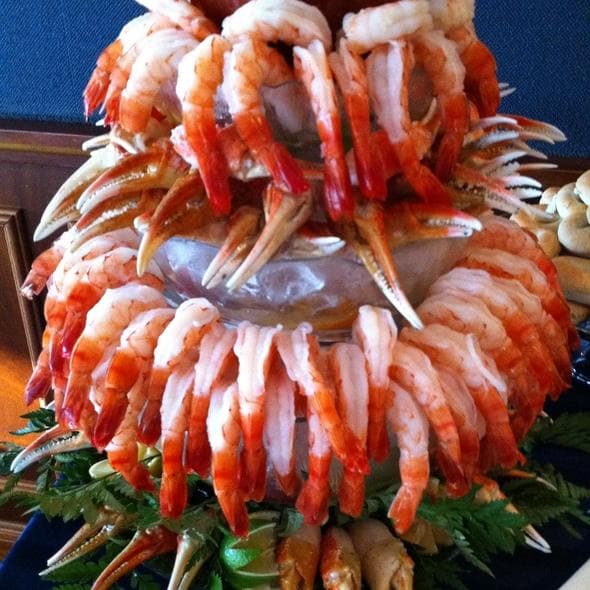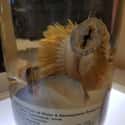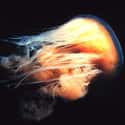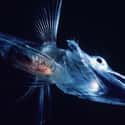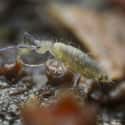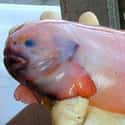-
(#6) Tardigrade
- Tardigrada
Tardigrades are one of the most unusual organisms found in Antarctica. They are also known as "water bears" for their plump bodies and clawed limbs, and are thought to be one of the tiniest creatures found on Earth. But anything that can survive in Antarctica shouldn't be judged by its size. In addition to being one of the smallest animals on the planet, they are also one of the oldest.
Tardigrades have the unique ability to remove all water from their bodies and replace it with a sugar, kind of like freeze-drying themselves in order to survive in harsh environments. They were even launched into space to test their tenacity. Most passed the test by surviving cosmic rays, normally deadly levels of UV radiation, and the vacuum of space with flying colors.
-
(#1) Eulagisca Gigantea
This crazy looking marine creature could only survive in two places: your worst nightmare and the Antarctic Ocean. Luckily it's confined to the ocean for now. It also goes by the descriptive title of "bristle worm."
The worm's fringe might seem bizarre, but its bristles help the creature crawl along the ocean floor, swim, and sometimes even defend itself against predators. Because it has sharp teeth, researchers believe the worm is a carnivore, and that it can possibly extend its jaws to catch its prey. To make things even weirder, the part that looks like its head is actually its throat.
-
(#8) Lion's mane jellyfish
- Cyanea capillata
The lion's mane jellyfish is the largest of them all; specimens as large as eight feet wide and 120 feet long have been found. It's also possible for them to have up to 1,200 tentacles, making their size seem that much larger. These jellies like to hang out near the surface of the ocean in the Arctic, and have been known to travel in groups.
One lion's mane jelly may have managed to sting more than 50 people who were swimming off the coast of New Hampshire in 2010. After a large number of people suffered stings on the same day, the corpse of a lion's mane jelly was found nearby. Since jellies can sting even after they're dead, it's possible that the deceased 40-pound creature somehow drifted in from colder waters and managed to inflict damage throughout a wide area.
-
(#3) Icefish
Icefish are literally some of the coldest-blooded creatures you'll find in the ocean. They'd have to be, if they wanted to survive in the Arctic. Icefish have developed several special features that allow them to thrive in icy waters. Their body temperature is able to adapt to the temperature of the water, and remains very cold. In fact, if they were to encounter higher temperature waters, they would actually die.
Icefish also create glycoproteins, which act as a sort of antifreeze to keep ice crystals from forming on their bodies. But the most unusual thing about these fish is that they lack hemoglobin. The blood of an icefish is white in color, and that, combined with their transparent bodies, allows them to camouflage themselves.
-
(#11) Springtail
- Collembola
Since seals and penguins are only visitors to, and not residents of, Antarctica, the continent's largest creature award goes to an arthropod. There are indeed insect-like organisms in Antarctica, proving there really is nowhere safe from creepy, crawly creatures. Springtails live under rocks along the coast of the continent, and like many other creatures that live in extreme environments, have specially adapted to live in the cold.
Although it is possible for them to freeze to death, springtails use glycerol to keep their bodies safe from temperatures that are too cold. They also have the special ability to slow down their metabolisms to save their bodies from using too much energy, and can go into a hibernation-like state when conditions get too extreme.
The name "springtail" comes from a tail-like protrusion under their abdomen which they use to jump great distances. This unique ability has also given them the nickname "snow fleas."
-
(#4) Snailfish
Snailfish are named for their loose, gelatinous skin that takes the place of scales. At the bottom of their tadpole-shaped bodies are giant suckers, which they use to attach themselves to rocks or other objects on the ocean floor. There are about 335 species worldwide, 20 of which make their home in Arctic waters.
They may be somewhat comical, but they have a unique ability: they can live in the deepest parts of the sea, including the Mariana Trench.
New Random Displays Display All By Ranking
About This Tool
In the extremely cold polar regions of the world, a variety of creatures thrive there with tenacious perseverance. There are the Arctic terns that travel to and from the poles of the earth, the emperor penguins, the beluga whales, and the polar bears that dominate the snow world, and more. These unique animals make the cold areas full of vitality.
Several birds and mammals have experienced long migrations and thrived in the polar regions and survived for generations, they have fully adapted to the harsh polar climate. Here the random tool lists 15 crazy animals in the polar regions that can not be found in any other region.
Our data comes from Ranker, If you want to participate in the ranking of items displayed on this page, please click here.

